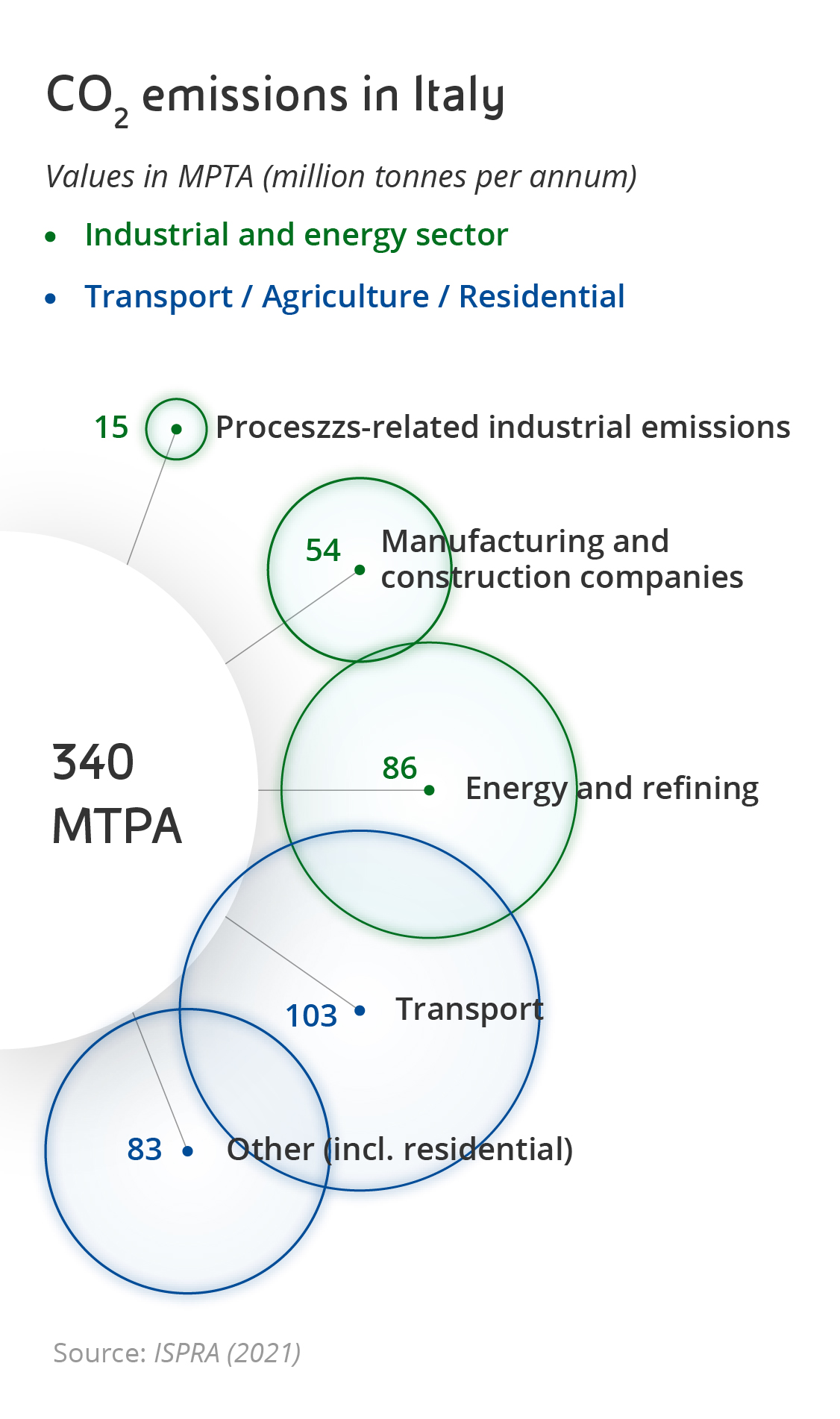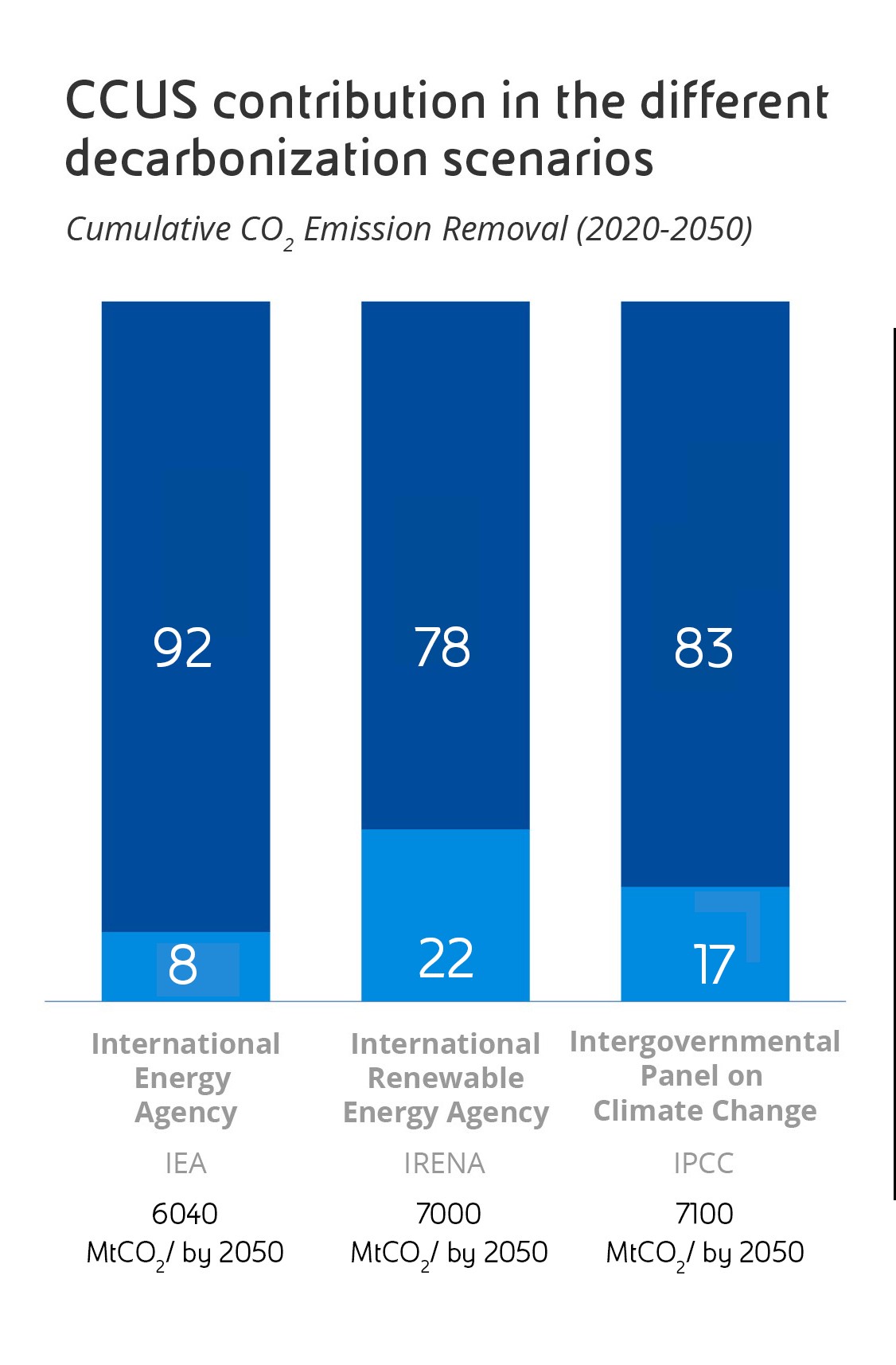
Carbon capture and storage (CCS) technologies are the most effective solution for immediately reducing emissions from hard-to-abate industrial operations.

Decarbonization is the term used to describe the gradual reduction in CO2 emissions from human activities that is crucial to combating climate change. This transition requires a profound transformation of our production system, using all the technological innovations at our disposal, from renewable energy sources to advanced biofuels, and from bio jet fuel to blue and green hydrogen . In this scenario, Carbon Capture and Storage (CCS) is the most rapid and efficient solution to immediately reduce the footprint of what we call hard-to-abate sectors. These are industries where, due to their energy-intensive nature and production processes, there are no current solutions to effectively and economically reduce emissions. Sectors such as iron and steel, cement, chemicals, paper and glass fit this description. Not only are their energy requirements such that they cannot be fully powered by renewables, but their core manufacturing processes also release emissions by their very nature, regardless of fossil fuel consumption. In some cases, these process-related emissions form a large part of the total; for example, in cement factories, around two-thirds of CO2 is produced by the calcination of limestone, a key stage in the production of cement. In 2021, Italy's building materials industry reported emissions of approximately 22 million tonnes (Mton) of carbon dioxide. Cumulatively, the hard-to-abate industries have a significant carbon footprint: in Italy alone, in 2021, they were responsible for about 68 Mton of CO2 out of a total of 337 Mton, which represents 20% of total emissions and 42% of the industrial sector alone, which recorded 155 Mton according to the Italian Institute for Environmental Protection and Research (ISPRA, 2023 data). Considering the fact that modern technology allows us to capture more than 90% of the CO2 contained in flue gases, CCS clearly offers a viable way to decarbonize hard-to-abate industries.

The decarbonization of electricity generation is a key element in view of the growing importance of electrification of final consumption (transport, residential, industrial, etc.) and the resulting forecast strong growth in demand. In this context, the decarbonization of high-efficiency gas-fired power plants through CCS can bring flexibility to the system by providing one of the most competitive and efficient programmable sources. This ultra-low emission programmable capacity will play a key role in accompanying and supporting the energy transition, by accompanying the increasing development of renewables needed to achieve the net zero target. In addition, the production of hydrogen from fossil sources made carbon neutral by CCS (referred to as blue hydrogen) is emerging as an economically advantageous solution in the short term, complementing the development of hydrogen from renewable sources (the so-called green hydrogen).
Some sectors have emissions that are difficult to reduce due to energy consumption and production processes (e.g. steel, cement, chemicals, paper).
CO2 emitted by the Cement industry and building materials in 2021
CO2 from Italian hard-to-abate industries (2021)
emitted by Italian industry in 2021 (ISPRA - Institute for Environmental Protection and Research)
Total CO2 emitted in Italy in 2021
CCS is a technological process that makes it possible to avoid atmospheric carbon dioxide emissions arising from large industrial plants and power plants. As such, it is considered by major international organisations (European Union, IPCC, UN and IEA) as an essential element of a sound and trustworthy medium- to long-term decarbonization strategy that harmoniously integrates different emission reduction solutions.
The IPCC's Sixth Assessment Report published in April 2022 shows that achieving net-zero carbon by mid-century, and thus limiting temperature rise to 1.5°C, will require the use of capture and storage technologies, particularly to significantly reduce emissions from industries that are otherwise difficult to decarbonize.
IPCC scientists have examined more than 2,000 climate models, and CCUS stands out as a key decarbonization tool in all scenarios that limit global temperature rise to a maximum of 2°C. In particular, of the 230 models that show a “high probability“ of keeping temperature increases below 1.5°C (the Glasgow CoP target), CCUS offers a significant contribution to emissions mitigation (an average of 7 billion tonnes by 2050 and between 14 and 16 billion tonnes by 2100).
In June 2023, the International Energy Agency published a report titled “World Energy Outlook 2023: 1.5°C Pathway“ This comprehensive analysis outlines the transition to a net-zero emissions energy system by 2050, ensuring steady and reliable security of energy supply, universal energy accessibility and robust economic development. The report also highlights the measures needed to achieve these goals, including the role of CCS.
In its assessment of the CCUS sector, the IEA concludes that these solutions can account for a 8% reduction in total emissions by 2050, particularly in the hard-to-abate sector. By then, the IEA predicts that 80% of the world's cement, 60% of chemicals and 50% of primary steel will have to be produced using methods that can capture emissions.
IRENA in the “World Energy Transitions Outlook 2023: 1.5°C Pathway“ predicts that CO2 capture will reach 7 Gtpa by 2050. Of this, 84% will come from the power and heat sector and the remaining 16% from industry.
The Industrial Carbon Management Strategy (2024), the European Commission aims to create a European market for industrial CO2 management by identifying targets for capture, transport and storage of 50 Mtpa by 2030 (in line with the Net Zero Industry Act - NZIA), 280 Mtpa by 2040 and 450 Mtpa by 2050.

CCUS can thus prove strategic in order to
Besides being essential in preventing new CO2 emissions from hard-to-abate sectors, CCS will also play a key role in the future in helping to remove the excess carbon dioxide that is already in our atmosphere, using Carbon Dioxide Removal (CDR) technologies to reduce its concentration from current levels (over 420ppm) to pre-industrial levels (around 280ppm).Although still evolving, CDR systems fall into two main categories: Direct Air Capture (DAC) and Bio-Energy with Carbon Capture and Storage (BECCS). The former involves building facilities that can filter large volumes of air and capture the CO2 that is present in it, while the latter involves using biomass as an energy carrier, capturing the resulting CO2 and storing it permanently. This process results in the generation of a part of negative emissions. Regardless of the technical differences between them, all of these approaches will require CCS infrastructures capable of trasporting and storing the large quantities of CO2 captured.
Eni's total direct emissions (Scope 1 and Scope 2) from its production activities worldwide amount to 41.2 Mton of CO2 equivalent per year, of which 18.5 Mton are produced in Italy. Thanks to this progressive increase in efficiency, from 2010 to 2019 Eni has already lowered its direct emissions by 29% due to its continuous innovation, the development and application of new technologies and further improvements in energy efficiency. In this context, the CO2 capture and storage (CCS) projects that Eni is developing in Italy, Europe and the rest of the world are a key part of the company's strategy to capturing residual emissions that cannot be avoided in any other way.
Snam has developed a plan to achieve carbon neutrality by 2040, with intermediate milestones to reduce greenhouse gas emissions by 2030.
In this context, Snam is unwavering in its commitment to achieve carbon neutrality for its operations by 2040, with further reduction phases for 2025, 2027 and 2030. In addition, Snam aims to gradually reduce Scope 1, 2 and 3 emissions in line with the Paris Agreement commitments to limit global temperature rise to 1.5°C.
A key player in steering the country towards a low-carbon future, Snam has diversified its business horizons beyond the regulated market into the energy transition sector. In recent years, its efforts and support for sustainable mobility have grown also by signing agreements and forging partnerships aimed at expanding Italy's network of distributors of compressed and liquefied natural gas (small-scale LNG, CNG), and it has made investments in companies promoting solutions for energy efficiency. Significant resources are also being devoted to the research into and introduction of sustainable renewable green gases such as biomethane and hydrogen, which can be transported and stored in increasing quantities using existing facilities.
Within this framework, the CO2 capture and storage (CCS) projects that Eni is developing in Italy, Europe and the rest of the world contribute to the company's strategy by reducing residual emissions that cannot be avoided in any other way.
Eni and Snam are developing a carbon capture and storage (CCS) project to reduce emissions from “hard to abate” industrial facilities.
Eni and Snam are developing a carbon capture and storage (CCS) project to reduce emissions from “hard to abate” industrial facilities.